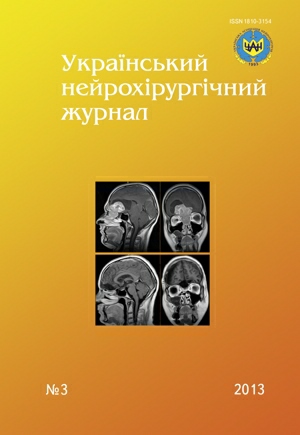Experimental study of safety of levofloxacin intrathecal application
DOI:
https://doi.org/10.25305/unj.54151Keywords:
levofloxacin, intrathecal application, safety, toxicityAbstract
Purpose: to set safety of levofloxacin intrathecal application in experiment on rats.
Materials and methods. In the experiment purebred white male rats were used in which clinical observation, general clinical and biochemical blood tests and electrocardiogram were done.
Results. There was the significant physiological weight gain of animals in main and control groups which is proof of the lack of negative effect of levofloxacin intrathecal application.
Studying the effect of levofloxacin intrathecal application on autonomic and behavioral functions in rats in first 2 h established short-term (up to 5 min) irritant. Studying hematological and biochemical parameters of blood of control and experimental animals no significant differences were revealed.
Conclusions. Levofloxacin intrathecal application in a doze 0.1875 mg/kg in combination with dexamethasone in a dose 0.05 mg / kg is safe.References
1. Zahner B, Erbguth F, Stefan H. [Acute meningoencephalitis--diagnosis and therapy]. Fortschr Med. 1995 Mar 20;113(8):97-101. German. [PubMed]
2. Ivanova MV, Vil'nits AA. Epidemiologiya bakterial'nykh gnoynykh meningitov u detey: opyt Sankt-Peterburga [The epidemiology of bacterial purulent meningitis in children: the experience of St. Petersburg]. Epidemiologiya i infektsionnyye bolezni. 2010;6:52-4. Russian.
3. Bykova RN, Koroleva IS, Gracheva AM, Demina AA, Platonov AYe, Beloshitskiy GV, Mironov KO, Zakroyeva IM, Spirikhina AV. Epidemiologicheskiy nadzor za gnoynymi bakterial'nymi meningitami: materialy 20-letnikh nablyudeniy [Surveillance of purulent bacterial meningitis: Materials 20-year observations]. Epidemiologiya i vaktsinoprofílaktika. 2003;5:10-13. Russian.
4. Vashukov SA, Polyashov AS, Porokhin VG. Lecheniye i profilaktika posttravmaticheskikh meningitov [Treatment and prevention of posttraumatic meningitis]. In: Abstract Book of the VIII All-Russia. Anaesthetist Congress; 2002; Omsk, Russia. Omsk, 2002. p.96. Russian.
5. Kubrakov KM, Kosinets AN, Akulenok AV. Intratekal'noye vvedeniye antibakterial'nykh preparatov u neyrokhirurgicheskikh bol'nykh s meningoentsefalitami [Intrathecal administration of antibacterial drugs in neurosurgical patients with meningoencephalitis]. Novosti khirurgii. 2008;16(4):86-93. Russian.
6. Tsarenko SV. Neyroreanimatologiya. Intensivnaya terapiya cherepno-mozgovoy travmy [Neyroreanimatologa. Intensive care of traumatic brain injury]. Moscow: Meditsina; 2006. Russian.
7. Trakhtenberg IM, Sova RV, Sheftel' VO, Onishenko VA. Pokazateli normy u laboratornykh zhivotnykh v toksikologicheskom eksperimente [Performance standards in laboratory animals in toxicological experiment]. Sovrem. predstavleniya i metodicheskiye podkhody, osnovnyye parametry i konstanty. [Modern presentation and methodological approaches, the basic parameters and constants]. Moscow: Meditsina; 1991. Russian.
8. Zapadnyuk IP, Zapadnyuk VI, Zakhariya YeA, Zapadnyuk BV. Laboratornyye zhivotnyye. Ispol'zovaniye v eksperimente [Laboratory animals. Using the experimental]. Kiev: Vishcha shkola; 1983. Russian.
9. Stepfanov OV, editor. Doklinichni doslidzhennya likarskykh zasobiv: metod. Rekomendatsiyi [Preclinical studies of drugs: Guidelines]. Kiev; 2001. Ukrainian.
10. Kovalenko VN, Viktorov AP, editors. Kompendium. Lekarstvennyye preparaty 2010 [Compendium. Drugs 2010]. Kiev: Morion; 2010. Russian.
11. Antunes-Rodrigues J, McCann S. Water, sodium chloride, and food intake induced by injections of cholinergic and adrenergic drugs into the third ventricle of the rat brain. Proc. Soc. Exp. Biol. Med. 1970;133(4):1464-70. [CrossRef] [PubMed]
12. Murashko VV, Strutynskiy AV. Elektrokardiografiya [Electrocardiography]. Moscow: Meditsina; 1991. Russian.
13. Evtanaziya eksperimental'nykh zhivotnykh: metod. rekomendatsii po vyvedeniyu zhivotnykh iz eksperimenta [Euthanasia of experimental animals: Guidelines for removing animals from the experiment]. Moscow: Meditsina; 1985. Russian.
14. Prokhorova VA, editor. Metody biokhimicheskikh issledovaniy [Methods of biochemical research]. Leningrad: Izd-vo Leningr. un-ta; 1982. Russian.
15. Tits NU, editor. Klinicheskaya otsenka laboratornykh testov [Clinical evaluation of the laboratory tests]. Moscow: Meditsina; 1986. Russian.
Downloads
Published
How to Cite
Issue
Section
License
Copyright (c) 2013 Sergiy Borshchov, Igor Filchakov, Petro Sinitsyn, Natalia Seredinskaya

This work is licensed under a Creative Commons Attribution 4.0 International License.
Ukrainian Neurosurgical Journal abides by the CREATIVE COMMONS copyright rights and permissions for open access journals.
Authors, who are published in this Journal, agree to the following conditions:
1. The authors reserve the right to authorship of the work and pass the first publication right of this work to the Journal under the terms of Creative Commons Attribution License, which allows others to freely distribute the published research with the obligatory reference to the authors of the original work and the first publication of the work in this Journal.
2. The authors have the right to conclude separate supplement agreements that relate to non-exclusive work distribution in the form of which it has been published by the Journal (for example, to upload the work to the online storage of the Journal or publish it as part of a monograph), provided that the reference to the first publication of the work in this Journal is included.









